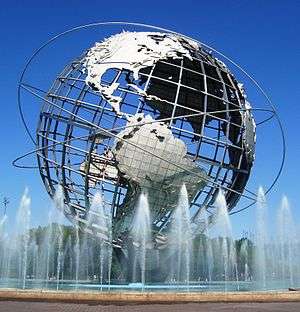Far Rockaway, Queens
| Far Rockaway | |
|---|---|
| Neighborhood of Queens | |
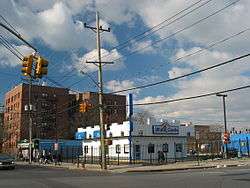 Far Rockaway street scene | |
|
<mapframe>: Attribute "align" has an invalid value
Location within New York City | |
| Coordinates: 40°36′04″N 73°45′25″W / 40.601°N 73.757°WCoordinates: 40°36′04″N 73°45′25″W / 40.601°N 73.757°W | |
| Country |
|
| State |
|
| City | New York City |
| County/Borough | Queens |
| Named for | Place name of the Native American Lenape. |
| Population (2010) | |
| • Total | 60,035 |
| Ethnicity | |
| • White | 31.0% |
| • Black | 50.1% |
| • Hispanic | 25.2% |
| • Asian | 2.0% |
| • Other | 14.3% |
| Economics | |
| • Median income | $27,820 |
| ZIP code | 11691 |
| Area code(s) | 718, 347, 929, and 917 |
Far Rockaway is a neighborhood on the Rockaway Peninsula in the New York City borough of Queens in the United States. It is the easternmost section of the Rockaways. The neighborhood extends from Beach 32nd Street east to the Nassau County line. The neighborhood is part of Queens Community Board 14.[1]
History
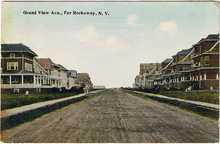
The name "Rockaway" may have meant "place of sands" in the Munsee language of the Native American Lenape who occupied this area at the time of European encounter during colonization. Other spellings include Requarkie, Rechouwakie, Rechaweygh, Rechquaakie and Reckowacky, transliterated in Dutch and English by early colonists.[note 1]
In September 1609, Henry Hudson and his crew were the first Europeans recorded as seeing the area of the Rockaways and Jamaica Bay.[2] Hudson was attempting to find the Northwest Passage. On September 11, Hudson sailed into the Upper New York Bay,[3] and the following day began a journey up what is now called the Hudson River in his honor.
Rockaway was, back then, inhabited by Canarsie Indians, a band of Mohegan, whose name was associated with the geography. The name Reckowacky, which is also spelled Requarkie, Rechouwakie, Rechaweygh, or Rechquaakie,[note 1] was to distinguish the Rockaway village from other Mohegan villages; "Reckowacky" means "lonely place", or "place of waters bright". (This area was mistakenly documented as occupied by a band of Mohawk people in a 1934 source, but this Iroquoian-speaking tribe primarily occupied the Mohawk River valley in central New York, north and west of the Hudson River and Long Island.)[4] By 1639, the Mohegan tribe sold most of the Rockaways to the Dutch West India Company.
In 1664, the English defeated the Dutch colony and took over their lands in present-day New York.[note 2][5] In 1685, the band chief, Tackapoucha, and the English governor of the province agreed to sell the Rockaways to a Captain Palmer for 31 pounds sterling.[2]
The Rockaway Peninsula was originally designated as part of the Town of Hempstead, then a part of Queens County. Palmer and the Town of Hempstead disputed over who owned Rockaway, so in 1687 he sold the land to Richard Cornell, an iron master from Flushing. Cornell and his family lived on a homestead on what is now Central Avenue, near the shore of the Atlantic Ocean. At his death, Cornell was buried in a small family cemetery, Cornell Cemetery. Today it is the only designated New York City landmark in the Rockaways.[2]
In the late 19th century, the Rockaway Association wanted to build a hotel on the Rockaway peninsula, as it was increasingly popular as a summer destination. The association, consisting of many wealthy members who had homes in the area, bought most of Cornell's old homestead property. They developed the Marine Hotel on that site, which attracted such guests as Henry Wadsworth Longfellow, Washington Irving, and the Vanderbilt family. The Rockaway Association also built the Rockaway Turnpike. The Marine Hotel burned to the ground in 1864, but more hotels and private residences were built in the area.[2]
In the 19th century, people traveled to the Rockaways by horse-drawn carriages or on horseback. A ferry powered by steam sailed from Lower Manhattan to Brooklyn. By the 1880s, the Long Island Rail Road's Rockaway Beach Branch was built to serve Far Rockaway station.[2] The steam railroad went to Long Island City and Flatbush Terminal (now Atlantic Terminal). When it opened in the 1880s, this connection stimulated population growth on the Rockaway Peninsula.[6] Benjamin Mott gave the LIRR 7 acres (2.8 ha) of land for a railroad depot. Land values increased and businesses in the area grew, and by 1888, Far Rockaway was a relatively large village.[2] It incorporated as a village on September 19 of that year.[7]
By 1898, the area was incorporated into the Greater City of New York, which included Queens. Far Rockaway, Hammels, and Arverne, all of Queens, tried to secede from the city several times. In 1915 and 1917, a bill approving the secession passed in the legislature but was vetoed by the New York City mayor John Purroy Mitchel.[8]
The Far Rockaway Beach Bungalow Historic District recognizes an area with a distinct character. This and individual properties, such as the Russell Sage Memorial Church, Trinity Chapel, and United States Post Office are listed on the National Register of Historic Places.[9]
Bungalows
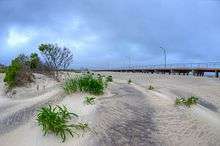
With its nearby beach, Far Rockaway attracted tourists and vacationers from the other boroughs. Bungalows were the homes of choice for many residents who lived in Far Rockaway. The railroad abandoned the Rockaway Beach Branch in 1950 because of the shift of many people to driving private cars. In addition, this destination had to compete with the many others that people were visiting by car and air travel, which created access to even more distant destinations and heightened competition for travel dollars.
As the neighborhood's heyday as a resort community declined in the 1950s, the city built substantial numbers of public housing developments to try to replace substandard housing after World War II. Bungalows and other residential housing were converted to year-round use for low-income residents. Some bungalows were used as public housing.[10][11] The 1970s New York City budget crisis resulted in a negative effect on the provision of social services, and problems of poverty, unemployment and drug use increased in this area.[12]
In September 1984, residents founded the Beachside Bungalow Preservation Association to "improve the quality of the Far Rockaway community through preservation, education, and cultural programs." "[13] The organization donated a collection of materials highlighting its history, correspondence, and activities to the Queens Library Archives in 2008.
Transportation
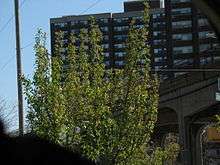
Far Rockaway is served by the following transportation services:
- The New York City Subway's IND Rockaway Line (A train), which has a terminal at Mott Avenue.[14][15]
- The Far Rockaway terminal station for the Long Island Rail Road's Far Rockaway Branch.[14] The branch had been part of a loop with service along the existing route, continuing through the Rockaway Peninsula and crossing on a trestle across Jamaica Bay through Queens, where it reconnected with other branches. Frequent fires and maintenance problems led the LIRR to abandon the Queens portion of the route. The city acquired this to develop the IND Rockaway Line.[16]
- MTA Regional Bus Operations: Q22, Q113, Q114, QM17[14][17]
- Nassau Inter-County Express: n31, n32, n33.[14][17] Unlike other NICE routes in Queens, these buses operate open-door in Far Rockaway, meaning customers can ride these buses wholly within the neighborhood without going to Nassau County.
- NYC Beach Bus. A shuttle bus between downtown Brooklyn or Williamsburg and the area around Beach 84 and Jacob Riis Park.
Parks
Education and library
The neighborhood, like all of New York City, is served by the New York City Department of Education. Far Rockaway residents are zoned to several different elementary schools:
- P.S. 43
- P.S. 104 The Bayswater School
- P.S. 105 The Bay School
- P.S. 106
- P.S. 197 The Ocean School
- P.S. 215 Lucretia Mott
- P.S. 253
Far Rockaway residents are zoned to M.S. 53 Brian Piccolo.
All New York City residents who wish to attend a public high school must apply to high schools. Far Rockaway High School was located in Far Rockaway, but was shut down in 2011 as a stand-alone institution. During the administration of Mayor Michael Bloomberg in 2011, many large, underperforming, older traditional high schools were closed in the city. The 1929 building was renovated to operate as the Far Rockaway Educational Campus, home to a number of smaller, specialized academies that share the building. They can provide more individualized attention to their students. The former Beach Channel High School was similarly closed in 2014 and repurposed to house several smaller, specialized academies; it is in Rockaway Park, near Far Rockaway, and draws some of its students from Far Rockaway.
Church of God Christian Academy is a K–12 co-ed school, located on Central Avenue.
Nikitas Language Abroad Schools, a series of language schools, is also located in Far Rockaway.
Challenge Preparatory Charter School on Hartman Lane is publicly funded and run by a private non-profit entity; it serves elementary and middle-school pupils.[18]
In 2013 New York magazine reported that the city planned to construct a public library in the neighborhood, to be designed by the internationally known architectural firm Snøhetta.[19]
Jewish institutions
During the early and mid-20th century, many Jewish immigrants and their working-class descendants settled in Far Rockaway, sometimes first as summer visitors. They founded numerous synagogues and private schools, including those devoted to single-sex education for Orthodox boys and girls. Following World War II, as residential housing was developed in Nassau and later Suffolk counties, many Jewish families left the Rockaways for newer housing.
Synagogues (past and present):
- Agudath Israel of Long Island
- Agudath Israel of Rockaway
- Agudath Israel of West Lawrence
- Bayswater Jewish Center
- Beis Medrash Ateres Yisroel (Rabbi Avraham Blumenkranz)
- Bnos Israel Institute (Rabbi Shmelke Rubin)
- Congregation Kneseth Israel in Far Rockaway
- Congregation Shaarey Tefila
- Congregation Shaarey Zedek
- Congregation Shomrai Shabbos
- Young Israel of Far Rockaway
- Young Israel of Wavecrest and Bayswater
Schools (past and present):
- Chaim Berlin High School
- Hebrew Academy of the Five Towns and Rockaway (HAFTR)
- Mesivta Chaim Shlomo
- Bnois Bais Yaacov
- Tichon Meir Moshe
- Sh'or Yoshuv Institute of Jewish Studies
- Siach Yitzchok Elementary School for Boys
- Torah Academy for Girls
- Bais Yaakov Ateres Miriam
- Yeshiva Darchei Torah
- Yeshiva of Far Rockaway
- The Hebrew Institute of Long Island
- Yeshiva Bnei Torah
Notable people
- Richard Bey (born 1951), talk show host; went to Far Rockaway High School.[20]
- Baruch Samuel Blumberg (1925–2011), winner of 1976 Nobel Prize in Medicine; graduated from Far Rockaway High School in 1942.[21]
- Joyce Brothers (1925–2013), family psychologist and advice columnist; grew up in Far Rockaway.[22]
- Chinx (1983–2015), rapper, grew up in both the Redfern Houses and Edgemere Houses (the latter are now known as Ocean Bay Apartments).[23]
- Cormega (born Cory McKay, 1970), rapper, lived in Far Rockaway as a youth.[24]
- Mac DeMarco (born 1990), Canadian songwriter and musician; has a house in Far Rockaway, where he recorded his album Another One.[25]
- Folorunso Fatukasi (born 1995), defensive end for the New York Jets.[26]
- Joan Feynman (born 1927), astrophysicist and NASA Exceptional Achievement Medal recipient.
- Richard Feynman (1918–1988), physicist and Nobel Prize winner; grew up in Far Rockaway and graduated from Far Rockaway High School.[21][27]
- Mary Gordon (born 1949), writer of novels, memoirs, and literary criticism, and professor at Barnard College; born in Far Rockaway and lived there for several years[28]
- Carl Icahn (born 1936), businessman and philanthropist; grew up in Far Rockaway and went to Far Rockaway High School.[21][29]
- Nancy Lieberman (born 1958), women's basketball pioneer; grew up in Far Rockaway[30][31]
- Bernard Madoff (born 1938), former American stockbroker, investment advisor, and financier who was convicted of fraud; went to Far Rockaway High School.[32]
- Steve Madden (born 1958), shoe designer and former CEO of Steve Madden Ltd; born in Far Rockaway.[33]
- Alice Nielsen (1872–1943), Broadway performer and operatic soprano; owned a house in Far Rockaway in the 1920s.[34]
- Phil Ochs (1940–1976), folk-protest singer; resided here for a period during childhood and died at his sister's home here.[35]
- Rammellzee (1960–2010), rap pioneer; born and died in Far Rockaway.[36]
- Burton Richter (born 1931), winner of 1976 Nobel Prize in Physics; graduated from Far Rockaway High School in 1948.[37]
- MC Serch (born 1967 as Michael Berrin), former member of the hip hop group 3rd Bass; grew up in Far Rockaway.[38]
- Raymond Smullyan (1919-2017), mathematician; grew up in Far Rockaway.[39]
- Herbert Sturhahn (1902–1979), football player elected to the College Football Hall of Fame; born in Far Rockaway.[40]
Notes
- 1 2 See Metoac#Exonyms and Toponymy of New Netherland.
- ↑ See New Amsterdam
References
- ↑ Queens Community Boards, New York City. Accessed September 3, 2007.
- 1 2 3 4 5 6
- "Rockaway... 'place of waters bright'", rockawave.com. Accessed March 16, 2015.
- "The Dean Georges Collection: Far Rockaway, Edgemer, Arverne". Rockaway Memories. Accessed March 16, 2015.
- ↑ Nevius, Michelle and James, "New York's many 9/11 anniversaries: the Staten Island Peace Conference", Inside the Apple: A Streetwise History of New York City, September 8, 2008. Accessed May 31, 2009.
- ↑ "Rockaway, The Playground of New York", Annual yearbook of the Rockaways, June 1934
- ↑ Henry L. Schoolcraft, "The Capture of New Amsterdam", English Historical Review (1907). Vol. 22 #88, pp 674–693 in JSTOR
- ↑ Jackson, Kenneth T., ed. (1995), The Encyclopedia of New York City, New Haven: Yale University Press, ISBN 0300055366 , p. 120.
- ↑ Documents of the Senate of the State of New York, Volume 8, p. 9. New Jersey Legislature, 1913. Accessed July 26, 2016.
- ↑ "The Rockaways". Rootsweb.com. Retrieved December 6, 2006.
- ↑ National Park Service (2010-07-09). "National Register Information System". National Register of Historic Places. National Park Service.
- ↑ "Beach Bungalow Historic District" (PDF). National Register of Historic Places Registration Form. National Park Service. 2013. Retrieved November 22, 2013.
- ↑ Wilson, Charles (March 16, 2012). "The Subway-Accessible, Surf-Ready, Urban Beach Paradise". New York Times Magazine. Retrieved December 8, 2013.
- ↑ "Fiscal crisis in 1975 taught New York hard lessons of chopping, freezing that are handy now". Daily News. New York.
- ↑ Autz, Lisa. "Far Rock Man Stands Up for Bungalows". TimesLedger Newspapers. Community Newspaper Group. Retrieved December 6, 2013.
- 1 2 3 4 "MTA Neighborhood Maps: The Rockaways" (PDF). mta.info. Metropolitan Transportation Authority. 2018. Retrieved October 1, 2018.
- ↑ "Subway Map" (PDF). Metropolitan Transportation Authority. January 18, 2018. Retrieved January 18, 2018.
- ↑ IND Rockaway Branch/Jamaica Bay Crossing, accessed June 14, 2006.
- 1 2 "Queens Bus Map" (PDF). Metropolitan Transportation Authority. December 2017. Retrieved April 24, 2018.
- ↑
- ↑ "Approval Matrix". New York magazine. Sep 30, 2013.
- ↑ Morales, Tina (February 25, 1990). "SCHOOL OF THE WEEK/Far Rockaway High School". Newsday. ProQuest Archiver. Retrieved November 25, 2015. (Subscription required (help)).
- 1 2 3 "The Best Queens Celebrities 2002", Queens Tribune. Accessed November 25, 2015.
- ↑ "Dr. Joyce Brothers: Television and Radio Writer, Producer, Host". The Paley Center For Media. Archived from the original on November 26, 2015. Retrieved November 25, 2015.
The daughter of lawyers, Joyce Diane Bauer was born in Manhattan and raised in Far Rockaway, Queens.
- ↑ "The Break Presents: Chinx Drugz". Xxlmag.com. February 17, 2012. Retrieved October 1, 2013.
- ↑ Golianopoulos, Thomas. "The Bridge Is Over; The Queensbridge Houses were once at the center of the rap universe. What happened to hip-hop's most storied housing project?", Complex (magazine), November 25, 2014. Accessed July 16, 2017. "Born Cory McKay in Brooklyn, Cormega moved at an early age from Bedford-Stuyvesant to Co-Op City in the Bronx where he lived on a 22nd floor apartment with a balcony. Life was good until his father discovered crack cocaine. Mega moved to Far Rockaway, Queens, and then he began dealing drugs in Brooklyn."
- ↑ "Video // Mac DeMarco Announces New Mini LP + Tour Dates". Captured Tracks. April 22, 2015. Retrieved April 23, 2015.
- ↑ Costello, Brian. "Jets land Far Rockaway native in sixth round", New York Post, April 28, 2018. Accessed October 9, 2018. "Gang Green picked defensive lineman Folorunso “Foley” Fatukasi in the sixth round, the 180th-overall pick. Fatukasi grew up in Far Rockaway and played at Beach Channel High School."
- ↑ "Richard Phillips Feynman Facts, information, pictures". Encyclopedia.com. June 10, 2010. Retrieved November 26, 2015.
- ↑ Crowe, Portia (May 4, 2015). "Carl Icahn told a story about his dad that always makes him tear up". Business Insider. Retrieved November 26, 2015.
- ↑ "Nancy Lieberman player profile". ODU Sports. Old Dominion University. Retrieved November 25, 2015.
On May 6, 2000, the Far Rockaway, NY native earned her degree from Old Dominion University in interdisciplinary studies.
- ↑ "Lieberman, Nancy". Encyclopedia.com. May 6, 1996. Retrieved November 25, 2015.
- ↑ Carney, John (December 22, 2008). "The Education of Bernie Madoff: The High School Years". Business Insider. Retrieved November 25, 2015.
- ↑ Dominguez, Robert (October 19, 2006). "BRINGING IT BACK HOME. Steve Madden's new ad campaign focuses on his fashion center - Queens". Daily News (New York). Retrieved November 25, 2015.
But Madden was born in Far Rockaway, Queens, where his family is from, and his corporate headquarters are in a huge, Tudor-style building in Long Island City not far from the Queensboro Bridge.
- ↑ McNamara, Pat (January 9, 2009). "We Love Our Nielsen". Patheos. Retrieved November 25, 2015.
- ↑ Tomasson, Robert E. (April 10, 1976). "Phil Ochs a Suicide at 35; Singer of Peace Movement". The New York Times. Retrieved November 25, 2015.
- ↑ Weiss, Jeff (July 1, 2010). "R.I.P. Rammellzee: The original abstract-rapping outlaw". Los Angeles Times. Retrieved July 3, 2010.
- ↑ "IN SEARCH OF THE Z PARTICLE", The New York Times, October 26, 1986. Accessed October 2, 2007. "BURTON RICHTER was born in Brooklyn 55 years ago, but grew up in Far Rockaway, Queens."
- ↑ Jackson, Brian Keith (October 24, 2007). "Ice, Ice Babies". NYMag.com. Retrieved November 25, 2015.
I grew up in Far Rockaway, and you’d always see shoes on the line.
- ↑ "Smullyan biography". University of St Andrews School of Mathematical and Computational Sciences. Retrieved November 25, 2015.
Raymond Smullyan, known as Ray, was brought up in Far Rockaway in New York City.
- ↑ "National Football Foundation > Programs > College Football Hall of Fame > SearchDetail". National Football Foundation > Home. Retrieved November 25, 2015.
External links
| Wikimedia Commons has media related to Far Rockaway, Queens. |
- Old Rockaway, New York, in Early Photographs by Vincent Seyfried, William Asadorian
- Far Rockaway: Abandoned Bungalows a 2009 photo essay by Nathan Kensinger
